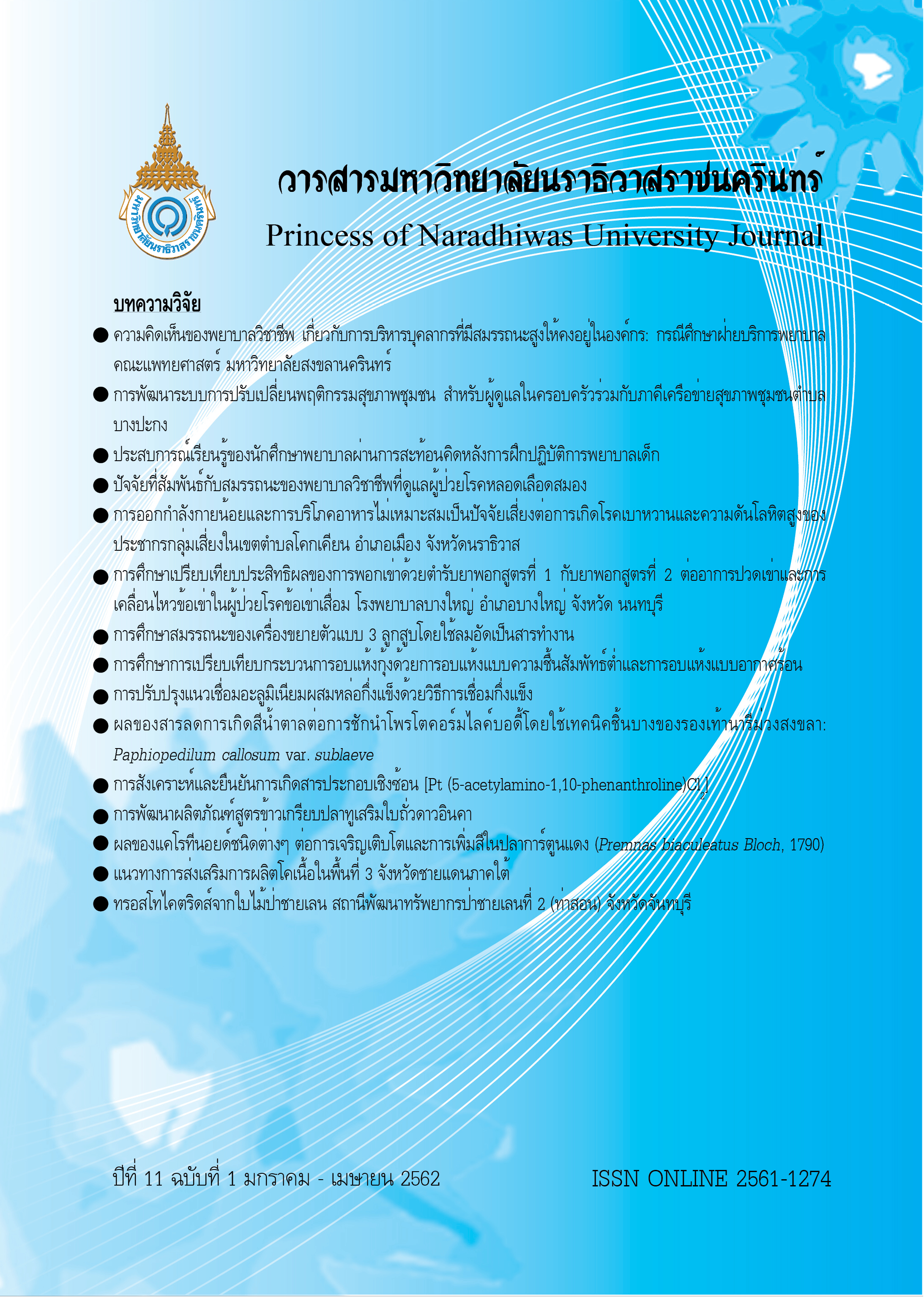Thraustochytrids from Mangrove Leaves at Mangrove Resources Development Station 2 Tha Son, Chanthaburi Province
Keywords:
Thraustochytrids, Mangrove forest, Fatty acids, Docosahexaenoic acid (DHA)Abstract
Diversity of thraustochytrids from fallen senescent leaves of 11 mangrove trees collected from
Mangrove Resources Development Station 2 Tha Son, Chanthaburi Province were investigated. A total of 123
isolates of thraustochytrids were found which classified into 3 species, namely Aurantiochytrium mangrovei,
Aurantiochytrium limacinum and Aurantiochytrium sp. The frequency of occurrence of these thraustochytrids
were 5 – 40 % and A. mangrovei was the predominant species. This study also found 21 isolates (1 species)of Aplanochytrids (Aplanochytrium sp.) which is close to a group of thraustochytrids and expressed as 5 –
35 % of occurrence. Consider with the species of mangrove trees, the percentage of occurrence were rather
high in leaves of Avicennia alba, Acrostichum aureum and Xylocarpus moluccensis. The highest biomass
was found in Aurantiochytrium sp. BUCHA0101 (18.01 ± 3.36 g/L), whereas A. limacinum, A. mangrovei,
and Aplanochytrium sp. were quit similar amount (15.35 - 16.77 g/L). For fatty acid content analyzed by
Gas Chromatography 6890, docosahexaenoic acid (DHA) was found in a range of 138.82 - 182.08 mg/g dry
wt. (29.69 – 34.99 % of total fatty acids), while docosapentaenoic acid and arachidonic acid were found of
28.99 – 43.63 mg/g dry wt. (6.57 – 8.38 % of total fatty acids) and of 0.38 – 0.46 mg/g dry wt. (0.08 – 0.10 %
of total fatty acids), respectively.
References
Bajpai, P., Bajpai, K., & Ward, P. O. (1991). Production of docosahexaenoic acid by Thraustochytrium aureum.
Applied Microbiology and Biotechnology, 35, 706-710.
Barclay, W. R., Meager, K. M., & Abril, J. R. (1994). Heterotrophic production of long chain omega-3 fatty acid utilizing algae and algae-like microoranisms. Journal of Applied Phycology, 6, 123-129.
Fan, K. W., Vrijmoed, L.L.P., & Jones, E.B.G. (2002). Physiological studies of subtropical mangrovethraustochytrids. Journal Botanica Marina, 45, 50-57.
Iamla-or, K., Jaritkhuan, S. & Suanjit, S. (2012). Diversity of Thraustochytrids in mangrove forest at Samutsakhon
Province. Aquatic Science, Burapha University. (in Thai).
Jantaban, J., Jaritkhuan, S. & Suanjit, S. (2007). Diversity of thraustochytrids isolated from mangrove leaves
at Bangkhunthean, Bankok. 8th National Grad Research Conference 7-8 September, 2007. Mahidol University, Salaya. (In Thai).
Jaritkhuan, S., Jones, E. B. G. & Bremer, G. 1998. Thraustochytrids as a food source in aquaculture. Paper presented at The Asia – Pacific Mycological Conference on Biodiversity and Biotechnology, 6 – 9 July, 1998. Hua Hin, Thailand.
Kamlangdee, N. & Fan, K. W. (2003). Polyunsaturated fatty acid production by Schizochytrium sp. Isolation
from Songklanakarin mangrove. Journal Science Technology, 25(5), 643-650.
Leano, M. (2001). Straminipilous organism from mangrove leaves from Panay Island, Philippines. Fungal Density, 6, 75-80.
Nagahara, T., Yokochi, T., Hihashihara, T., Tanaka, S., Yaguchi, T., & Honda, D. (1996). Production of decosahexaenoic and docosapentaenoic acid by Schizochytrium sp. isolate from Yap Island. Journal of the American oil Chemists Society, 73(11), 1421-1426.
Nagahuma, T., Takasugi, H. & Kimura, H. (1998). Abundance of thraustochytrids in coastal plankton. Marine Ecology Progress Series, 162, 105-110.
Naganuma, T., Kimura, H. Karimoto, R., & Pimenov, N. V. (2006). Abundance of planktonic thraustochytrids
and bacteria and concentration of particulate ATP in Greenland and Norwegian Seas. National Institute of Polar Research, 20, 37-45.
Natiwaranon, S. (2003). The role of fat in health. Charpa, 11(80), 62-66.
Prayunpun, M., Jaritkhuan, S. Suanjit, S. & Manthachitra, V. (2006). Thraustochytrids isolated from fallen
mangrove leaves at Mueang District, Samut Prakan Province. Aquatic Science, Burapha University. (in Thai).
Shimizu, S., Kawashima, H., Shinmen, Y., Akitamo, K., & Yamada, H. (1988). Production of eicosapentaenoic acid by Mortierella fungi. Journal on the American oil chemists Society, 65, 1455-1459.
Yimyuan, K., Jaritkhuan, S. & Suanjit, S. (2007). Diversity and fatty acid composition in Thraustochytriuds
isolated mangrove leaves at Leam Pak Bia, Phetchaburi Province. Environmental Science, Burapha University. (in Thai).
Yokochi, T., Honda, D., Higashihara, T., & Nakahara, T. (1998). Optimization of docosahexaenoic acids production by Schizochytrium limacinum SR21. Applied Microbiology and Biotechnology, 49, 72-76.
Yokoyama, R., & Honda, Y. (2007). Taxonomic rearrangement of the genus Schizochytrium sensu lato based on morphylogy, chemotaxonomic characteristics, and 18S rRNA gene phylogeny (Thraustochytriaceae, byrintolomycetes): emendation for Schizochytrium and erection of Aurantiochytrium and Oblongichytrium gen. nov. Mycoscience, 48, 199-211.




